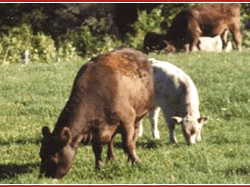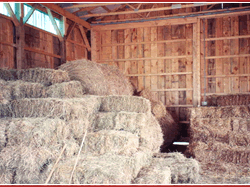Dennis Starkey
Hillview Farm
R.R. #4, Durham, Ontario N0G 1R0
Tel: (519) 369-6966
grassrootsmeats@gmail.com



You Are What Your Animals Eatby Jo RobinsonIn my investigation into pasture-based farming, I've stumbled upon an alarming void: few people care about the link between the diet of our livestock and the nutritional content of their products. "Feed animals anything you want," the research suggests, "and it makes no difference to their meat, milk or eggs." Browse through the animal science journals, for example, and you'll see that the goal of most feeding experiments is to increase production and minimize costs. Period. As long as the feed is cheap and the animal gets fat, anything goes.
Researchers studying human nutrition have been slow to see a connection between animal diets and human diets. To most dieticians, beef is beef, eggs are eggs, and milk is milk. Few are paying attention to what the animals were fed or how they were raised. Thus, when the guidelines say "eat less red meat", the edict applies to all red meat, whether it's a fatty steak from a grain fed cow, or a lean steak from a grass fed cow with its invisible bounty of omega-3's, vitamin E, and CLA. I have spent the last three years trying to connect the dots between animal feed and human food. It has been arduous work. For the past 50 years or so, virtually all of our information about the nutrition of meat has come from grain fed animals. To discover the nutritional value of grass fed products, I've had to search through mouldy journals published before the advent of factory farming, extrapolate from small studies, and rely on studies based in Ireland, Australia, or New Zealand - parts of the world where pasture-based farming still survives. Finding the amount of vitamin E in grass fed beef, has been my biggest challenge. I began to search for this data as soon as I learned that grass has 20 times more vitamin E than corn or soy. Given the magnitude of this difference, I reasoned that meat from grass fed animals must have an extra helping of vitamin E. Diligently, I searched the scientific record. At long last, I located one study that compared the amount of vitamin E in grain fed and grass fed meat. The impetus for the study came from disgruntled Japanese buyers who complained that the meat from American feedlot cattle spoiled more quickly than the meat from Australian free-range cattle. To find out why, the Americans decided to measure the vitamin E levels in the two types of meat. Their tests revealed that meat from grass fed cattle has three to four times more vitamin E than meat from feedlot cattle. How did they use this data? They decided to add more artificial vitamin E to feedlot diets. What can be done about the lack of interest in raising animals in a more natural environment? The underlying problem is that most of our animal research is funded by commercial interests - primarily the grain, chemical, pharmaceutical, farm equipment, and meat-packing companies. Together, these vertically integrated behemoths have a multi-million dollar investment in perpetuating factory-farming. The USDA, meanwhile, devotes the bulk of its efforts to supporting and tweaking the feedlot system that is more willing to spend $100, 000 on a new piece of equipment that's designed to measure the odour that wafts off manure lagoons than to spend a similar amount on exploring the odour-free grazing system. What will it take to rearrange priorities? What will it take to enlighten the public? A sustained media campaign. But since there is no money to fund such a campaign, the breakthrough will have to come from investigative journalism. A journalist from a major TV show or a prestigious newspaper will decide to explore the stunning differences between raising animals on pasture and in confinement. Building on this ground-breaking work a respected TV journalist will produce a one-hour documentary on pasture-based farming. The program will conclude that raising cattle on pasture is better for consumers, animal welfare, the environment, and small-scale farmers. Before long, dozens of TV shows, newspapers, and magazines will have followed suit and launched their own investigations into this "new" phenomenon.
All of a sudden, grassfarming will be the talk of the town. Serving organic meat won't win points at society dinners anymore unless it's grass fed as well. Propelled by this groundswell of interest, investors and institutions will finally devote more time, money and energy to supporting pasture-based farming. Will grassfarming really become the darling of the media? There is evidence that grassfarming is gathering momentum the old-fashioned way - word of mouth. People are telling friends about the health benefits of pastured animal products, and they're turning the curious into converts by inviting them over to share in a feast. The few grassfarmers are having trouble keeping up with the demand. The good news about grassfarming seems to be spreading - one satisfied customer at a time! Jo Robinson is a New York Times bestselling writer. Visit her website www.eatwild.com to find new research about grassfarming. Purchase her book, Why Grassfed Is Best. Vachon Press |
Other articles
Grassfed basics |
 Home
Home

